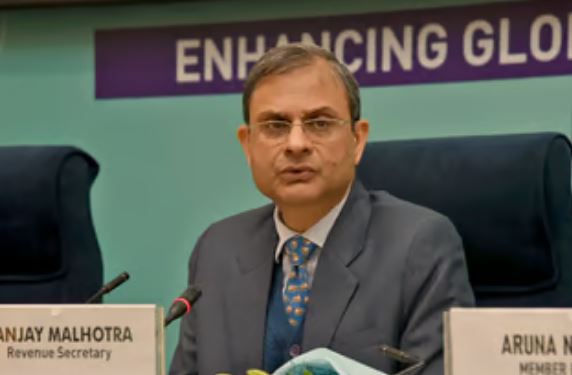Mumbai: Home, auto and other loans are likely to see a drop in interest rates after the Reserve Bank of India under a new Governor cut the key benchmark rate Friday for the first time in almost five years to spur a sluggish economy.
The Monetary Policy Committee, headed by RBI Governor Sanjay Malhotra, slashed the repo rate by 25 basis points to 6.25 per cent. This was the first reduction since May 2020 and the first revision after two-and-a-half years.
Malhotra, a career bureaucrat who replaced Shaktikanta Das barely days after the last bi-monthly MPC meeting in December, said the Indian economy will grow at 6.7 per cent in the fiscal starting April 2025 while the inflation rate to be lower at 4.2 per cent.
The growth-inflation dynamics “opens up policy space for the MPC to support growth” he said, adding that the RBI will “remain unambiguously focused on a durable alignment of inflation with the target while supporting growth.”
For the financial year ending March 31, the Reserve Bank quoted the government estimate to put the growth rate at 6.4 per cent, its worst in four years and lower than the 6.6 per cent seen previously, while the inflation was pegged at 4.8 per cent.
While his predecessor held rates in waiting for inflation to drop to the 4 per cent level, the RBI under Malhotra tilted towards supporting growth in the inflation-growth trade-off.
While the policy rate was reduced, the MPC kept the stance unchanged at neutral. This could imply a more cautious approach towards the extent of rate cuts going forward in this rate-cutting cycle.
The repo rate (repurchase rate) is the interest rate at which the central bank lends money to commercial banks when there is a shortage of funds.
When the repo rate is high, borrowing costs for banks increase, which is often passed on to consumers in the form of higher interest rates on loans.
Conversely, a lower repo rate usually results in lower interest rates on loans such as home loans, car loans, and personal loans.
Repo rate also decides the returns on savings and investment products. A higher repo rate can lead to better returns on fixed deposits and other savings instruments, as banks offer higher interest rates to attract deposits. On the flip side, lower repo rates might reduce the interest earned on these savings products.
The MPC, which consists of three RBI and three external members, “decided unanimously to reduce the policy repo rate by 25 basis points from 6.50 per cent to 6.25 per cent,” Malhotra said.
Explaining the rationale for the decision, he said inflation has declined.
“Supported by a favourable outlook on food and continuing transmission of past monetary policy actions, it is expected to further moderate in 2025-26, gradually aligning with the target (of 4 per cent).”
The MPC also noted that though growth is expected to recover from the low of July-September 2024 (when it grew by 5.4 per cent – its slowest expansion in nearly two years), it is much below last year’s levels.
“These growth-inflation dynamics open up policy space for the MPC to support growth while remaining focussed on aligning inflation with the target,” he said.
Following a peak in October, consumer price inflation eased to 5.22 per cent in December and 5.48 per cent in November. But it remains above the 4 per cent target.
“Considering the existing growth-inflation dynamics, the MPC, while continuing with the neutral stance, felt that a less restrictive monetary policy is more appropriate at the current juncture. The MPC will decide for each of its future meetings based on a fresh assessment of the macroeconomic outlook,” he said.
Malhotra added that the RBI was committed to making carefully calibrated monetary policy decisions to facilitate conducive macroeconomic conditions that reinforce price stability, sustained economic growth and financial stability.
In the post-policy press briefing, Malhotra suggested the RBI’s primary objective is price stability while keeping in view economic growth.
Asked if the RBI will be comfortable with inflation in the target range of 2-6 per cent, the Governor said the focus will remain on the 4 per cent midpoint.
Malhotra reiterated that RBI’s foreign exchange intervention was aimed at curbing excessive volatility but the central bank wasn’t targeting a specific level or band. A weaker rupee puts pressure on inflation, but a bigger worry is global uncertainty and how that pans out, he said.
Stating that RBI remained committed to providing sufficient liquidity to the financial system, he said, “We are always watchful, we will be nimble and I want to assure that we will be very very proactive in whatever liquidity requirements are needed.”
Though growth is expected to recover from the low of the second quarter ended September, it is still “much below that of last year,” Malhotra said.
“These growth-inflation dynamics open up policy space for the MPC to support growth while remaining focused on aligning inflation with the target.” Following the policy, the Indian rupee strengthened marginally to 87.47 against the US dollar.
Commenting on the rate cut, Ajit Velonie, Senior Director, Crisil Ratings, it would provide a boost to consumption and retail credit, though the transmission would take time.
Veena Sivaramakrishnan, Partner, Shardul Amarchand Mangaldas, said floating rate loans and structured products can see an immediate impact in favour of the borrowers/ issuers.
Radhika Rao, senior economist, at DBS Bank, said an emphasis on the flexibility of the inflation targeting framework suggests the MPC might be more tolerant of intermittent modest supply-driven volatility.
Suman Chowdhury, chief economist at Acuité Ratings & Research Limited, said that the Governor’s speech seems to suggest that the approach to inflation targeting will be a little more flexible.
PTI
